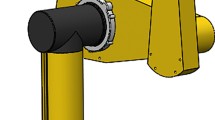Abstract
To solve the problem velocity control for robot end-effectors trajectory planning in the Cartesian space, this paper studied the algorithm of the linear acceleration and deceleration. Moreover, it proposed a velocity optimization algorithm based on the displacement equivalent. Adjusting the speed size of the acceleration and deceleration, the algorithm reduced the velocity mutation due to the discretized interpolation equation. The algorithm then was applied to the linear and circular interpolation of 4-degree of freedom industrial robots, establishing the forward and inverse kinematics equation based on Denavit–Hartenberg (D–H) coordinate system with implementing the optimization algorithm in the motion control system. Next, the velocity of the end-effectors was tested using the acceleration sensor and data logger. The results of simulation and experiment showed that velocity optimization algorithm eliminated the acceleration point and decreased the deceleration point on the velocity mutation.










Similar content being viewed by others
References
Chen, Y., Wang, T., Wei, H., et al.: Linear and S-shape acceleration and deceleration for CNC machine tools. China Mech. Eng. 17(15), 1600–1604 (2006)
Chen, Y., Wei, H., Wang, Q.: Sampled-data algorithm of linear and S shape acceleration and deceleration for CNC controller. China Mech. Eng. 21(5), 567–570 (2010)
Yin, J., Luo, F.: Equivalent transformation algorithm for motion time periodization of acceleration and deceleration before interpolation. China Mech. Eng. 25(24), 3320–3325 (2014)
Luo, J., Zong, L., Wang, M., Yuan, J.: Optimal capture occasion determination and trajectory generation for space robots grasping tumbling objects. Acta Astronaut. 136, 380–386 (2017)
Chu, Z., Ma, Y., Hou, Y., Wang, F.: Inertial parameter identification using contact force information for an unknown object captured by a space manipulator. Acta Astronaut. 131, 69–82 (2017)
Liu, P., Yang, M., Song, K., et al.: Study of S-curve’s application on manipulator’s trajectory interpolation algorithm. Manuf. Autom. 34(10), 4–11 (2012)
Leng, H., Wu, Y., Pan, X.: Velocity planning algorithm for high speed machining of micro line blocks based on cubic polynomial model. Comput. Integr. Manuf. Syst. 14(2), 336–340 (2008)
Nam, S.H., Yang, M.Y.: A study on a generalized parametric interpolator with real-time jerk-limited acceleration. Comput. Aided Des. 36(1), 27–36 (2004)
Zheng, K., Zhong, H.: Velocity control method of 5-axis simultaneous computerized numerical control system. Comput. Integr. Manuf. Syst. 13(5), 950–966 (2007)
Wang, Y., Xiao, L., Zeng, S., et al.: An optimal federate model and solution for high-speed machining of small line blocks with look-ahead. J. Shanghai Jiaotong Univ. 38(6), 901–904 (2004)
Li, J., He, S., Wu, H.: Linear interpolation algorithm and its application in robot. J. Mech. Electr. Eng. 32(7), 966–970 (2015)
Leng, H., Wu, Y., Pan, X.: New single segment acceleration and deceleration control method based on cubic polynomial model. J. Zhejiang Univ. (Eng. Sci.) 42(8), 1440–1444 (2008)
Zhou, Q.: Electron. Commer. Res. (2017). https://doi.org/10.1007/s10660-017-9265-8
Zhou, Q., Liu, R.: Clust. Comput. 19, 2109 (2016). https://doi.org/10.1007/s10586-016-0655-9
Zhou, Q.: Clust. Comput. 19, 1275 (2016). https://doi.org/10.1007/s10586-016-0580-y
Chen, G., Hu, X., Wang, M.: Trajectory planning and applications for the circular motion of manipulator. J. Huazhong Univ. Sci. Technol. (Nat. Sci. Ed.) 33(11), 63–66 (2005)
Acknowledgements
This work is funded by Zhejiang Province Public Welfare Technology Application Projects of China (2017C31036), and National Natural Science Foundation of China (NSFC) (U1609205, 51675488, 51307151), and Doctoral Research Foundation of Zhejiang Sci-Tech University (13022155-Y), and Zhejiang Province New Century 151 Project of China (11130031511703), and Zhejiang Province Key Major of Mechanic Engineering (ZSTUME01B07), and Zhejiang Provincial Natural Science Foundation of China (LY18E070006, LY18E050016).
Author information
Authors and Affiliations
Corresponding authors
Rights and permissions
About this article
Cite this article
Zhang, H., Lu, W., Wu, C. et al. Velocity optimization algorithm of 4-DOF robot end-effectors. Cluster Comput 22 (Suppl 3), 6305–6314 (2019). https://doi.org/10.1007/s10586-018-2037-y
Received:
Revised:
Accepted:
Published:
Issue Date:
DOI: https://doi.org/10.1007/s10586-018-2037-y




